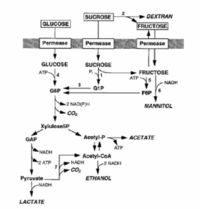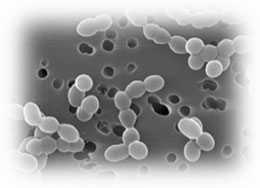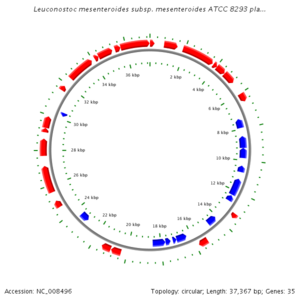Leuconostoc
A Microbial Biorealm page on the genus Leuconostoc
Classification
Higher order taxa:
Bacteria; Firmicutes; Bacilli; Lactobacillales; Leuconostocaceae
Species:
L. carnosum, L. citreum, L. durionis, L. fallax, L. ficulneum, L. fructosum, L. garlicum, L. gasicomitatum,
L. gelidum, L. inhae, L. kimchii, L. lactis, L. mesenteroides, L. pseudoficulneum, L. pseudomesenteroides
|
NCBI: Taxonomy |
Description and Significance
Leuconostocs are traditionally found in association with plant matter, fermenting vegetables, milk, dairy products, and wines and meats. Leuconostocs were first isolated in 1878 by Cienkowski. Leuconostoc usually nonpathogenic acid-tolerant organisms with optimal temperature 18 and 25°C, but the group is quite diverse. For example, L. carnosum is an anaerobic bacterium found in spoiled, packaged meat. Optimal temperature for the organism is 2°C. L. carnosum able to inhibit growth of other (even closely related) bacteria. So, it may be used as biopreservative. Leuconostoc in general is important to fermentation of vegetables.
Genome Structure
The genome of Leuconostoc is comprised of 2,038,396 bp with 2,075,763 nucleotides arranged in a circular design, and encodes for 2005 different proteins, with 54% of them being assigned putative biological functions. The G-C content of 37-40% has been reported as standard. As Luconostoc spp. is a lactic acid bacteria, the genome encoded all enzymes present in the 6-phosphogluconate phosphoketolase pathway. Genes were also found that encoded pyruvate dissipating enzymes that are predicted to catalyze the production of many metabolites leading to various end products of fermentation. Additionally, certain species of Leuconostoc were found to contain plasmids, randing from 1-7, ranging from 1.3 to 80Mda with genes that encode for bacteriocin production and citrate metabolism. (F. Breidt Jr. and Plengvidhya, Vethachai)
Cell Structure and Metabolism

Leuconostoc is a coccus, often lenticular on agar and usually occurs in pairs or chains. Leuconostoc is nonmotile, not spore forming bacteria. It is catalase-negative nonproteolytic organism without cytochromes. Leuconostoc is nonhemolytic, vancomycin resistant organism. It is heterofermentative (uses a combination of the pentose phosphate and phosphoketolase pathways). (Thunnel 1995) L. mesenteroides able to convert sugar to mannitol and dextran. For many foods, such as fruit juice or milk products, Leuconostoc can contribute to off flavors due to diacetyl production. in certain alcohols, meats, vegetable, and fermented milk products like cheese or yogurt, though, it is often used as a starter culture for the same diacetyl production capacity.
Leuconostocs, like other LAB, do not contain a tricarboxylic acid cycle or a cytochrome system and so cannot derive energy from oxidative phosphorylation. Instead, they obtain energy through substrate level phosphorylation, during the fermentation of sugars to lactic acid, ethanol or acetate, and C02. Citrate and malate are the two major organic acids metabolized by leuconostocs. Metabolism of the former is important in fermented dairy products and that of the latter in wine. Leuconostocs able to metabolize oxygen to 02-,H202, or water in the presence of an oxidizable substrate(Timothy M. Cogan and Kieran N. Jordan)
Ecology
Leuconostoc can often be found in the wild and is a part of the natural microflora in almost all farming fields. It is most commonly found in many different processed foods (in sugar processing liquors and fermented foods, including olives, cucumbers, sauerkraut, wine and cheese), either as a starter culture or as a contaminant. Leuconostoc is a gram-positive chemoorganoheterotrophic bacteria. It is facultative anaerobe. Leuconostoc requires rich, complex media (nicotinic acid, thiamin, biotin, and pantothenic acid or one of its derivatives). Leuconostoc are found in mesophilic mixed-strain cultures but not in thermophilic starter cultures.
Industrial Uses
Members of Leuconstoc spp. are very often used in production of fermented foods because of their ability to produce lactic acid and diacetyl. Leuconstoc mesenteroides is used primarily in saurkraut production, where its heterofermentative abilities are used in the first stage of four to convert glucose and fructose in cabbage to lactic acid, mannitol, acetic acid, ethanol, and carbon dioxide. In fermented milk and meat products, diacetyl is responsible for butter flavor and the other fermentation products aid in the preservation and palatability of the food. Also, Leuconstoc carnosum produces bacteriocins, and these are used to inhibit Listeria monosytogenes in dairy and meat products.


